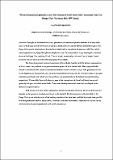Por favor, use este identificador para citar o enlazar a este item:
http://hdl.handle.net/10261/17557COMPARTIR / EXPORTAR:
 SHARE SHARE
 CORE
BASE CORE
BASE
|
|
| Visualizar otros formatos: MARC | Dublin Core | RDF | ORE | MODS | METS | DIDL | DATACITE | |

| Título: | Three-dimensional geometry and interference of fault-bend folds: examples from the Ponga Unit, Variscan Belt, NW Spain |
Autor: | Alvarez-Marrón, Joaquina CSIC ORCID | Fecha de publicación: | abr-1995 | Editor: | Elsevier | Citación: | Journal of Structural Geology 17(4): 549-560 (1995) | Resumen: | Examples of the three-dimensional geometry and interference patterns between fault-bend folds occur in the Ponga Unit of the Variscan Cantabrian foreland thrust and fold belt of NW Spain. The Ponga Unit consists of several E-directed thrust sheets with a cumulative displacement of 93 km, which were emplaced during Upper Westphalian-Stephanian time. Two major lateral ramps developed in the basal thrust of the Ponga Unit, reaching 15 and 20 km in length, respectively, and some 3 km in height. Lateral structures are also common within the hangingwall thrust sheets. The three-dimensional staircase trajectories of thrust faults, together with the tectonic superposition of thrust sheets, has produced a complex interference pattern of fault-related folds. Most map-scale folds formed as fault-bend folds related to interference between frontal and lateral ramps. Fold geometry and size varies depending on the geometry and size of the associated thrust ramp and flat. The axial traces are grouped into lateral and frontal sets, which are sub-parallel or sub-perpendicular to the tectonic transport direction, respectively. ‘Corner folds’ form with plunging axes at the intersections of frontal and lateral ramps and generally link pairs of frontal-lateral folds. They have relatively short axial traces that are oblique to the tectonic transport direction. Fold plunge varies due to the superposition of lateral and frontal structures of a thrust fault and also depends on the geometry of subsequent thrusts in the footwall. The final geometry of frontal folds in the Ponga Unit are not only the result of the bending mechanism but have been modified by simple shear parallel to the emplacement direction. Major lateral structures have been reactivated as reverse faults and are locally overturned due to post-emplacement north-south compression. |
Descripción: | 12 pages, 11 figures.-- This work forms part of a Ph.D. thesis supervised by A. Pérez-Estaun and and J. L. Alonso. | Versión del editor: | http://dx.doi.org/10.1016/0191-8141(94)00075-B | URI: | http://hdl.handle.net/10261/17557 | DOI: | 10.1016/0191-8141(94)00075-B | ISSN: | 0191-8141 |
| Aparece en las colecciones: | (Geo3Bcn) Artículos |
Ficheros en este ítem:
| Fichero | Descripción | Tamaño | Formato | |
|---|---|---|---|---|
| Alvarez-Marron_1995_manusc.pdf | 1,08 MB | Adobe PDF |  Visualizar/Abrir |
CORE Recommender
SCOPUSTM
Citations
37
checked on 11-abr-2024
WEB OF SCIENCETM
Citations
34
checked on 26-feb-2024
Page view(s)
365
checked on 17-abr-2024
Download(s)
507
checked on 17-abr-2024
Google ScholarTM
Check
Altmetric
Altmetric
NOTA: Los ítems de Digital.CSIC están protegidos por copyright, con todos los derechos reservados, a menos que se indique lo contrario.
